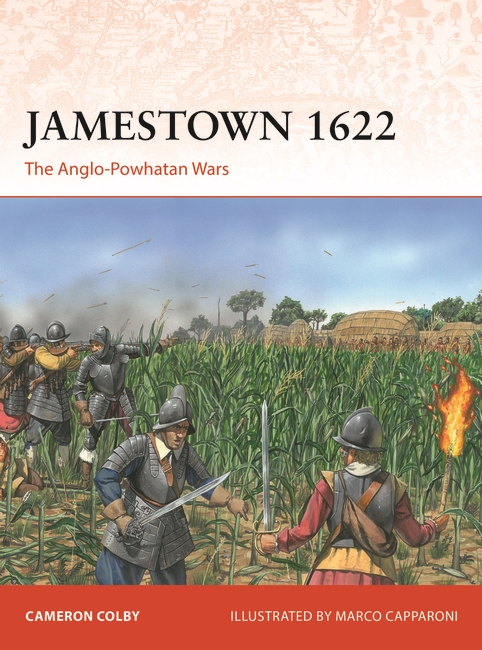
English men stepped ashore along the banks of the Chesapeake for the first time in May 1607. The men of the Virginia Company established Jamestown, a new foothold in the New World, but, unbeknownst to them, they had settled in the heart of the Powhatan Confederacy. This extensive and developed confederacy of tribes challenged English expansion at every turn. From the first widespread violence in 1609 to the final campaign of 1645, English and Powhatan warriors vied for control of what became known as the James River and Virginia Peninsula. This addition to the Campaign series examines the First and Second Anglo-Powhatan wars in detail, expanding on the military tactics used by the English and Powhatans.
Setting the colonization of Virginia within the context of previous Elizabethan growth and England’s continued competition with Spain clarifies the goals and challenges of the early settlers of the New World. English dreams of an overseas empire slowly became a reality through extreme loss of life and hardship at Jamestown. But before the arrival of the English, Chief Powhatan had consolidated his confederacy to create a united front. Understanding Powhatan goals and troubles with neighbors to the north and west rationalize many of the decisions pursued against the English desire for goods and land.
The First Anglo-Powhatan War (1609–14) saw leadership from a revolving list of English commanders. Each English leader left a mark on the nascent colony and shaped the military engagements of the first and second conflicts. Three leaders defined the decisions of the Powhatan Confederacy throughout this period: Chief Powhatan, Itoyatin, and Opechancanough. These three half-brothers pursued separate agendas to challenge the English settlers and develop alliances that benefited the confederacy.
The relational nature of alliances in the Powhatan world drew the first conflict to an end with the marriage of Pocahontas to John Rolfe. Both cultures recognized marriage as a way to cease conflict and tie their peoples together. After a few years of relative peace, Chief Powhatan's death and a rapid rise in English tobacco production triggered a second conflict. Chief Itoyatin and his second-in-command, war chief Opechancanough, planned a deliberate surprise attack which intended to drive the English into the ocean for good. The massacre of March 1622 started the Second Anglo-Powhatan War. From 1622 to 1634, English leaders conducted marches similar to those in Ireland and Scotland to keep continual pressure on the Powhatan tribes and cripple indigenous resistance.
Led by John Smith, Thomas Dale, and others, English soldiers in Virginia brought the experiments and experience of European warfare to the Virginian battlefield. Similarly, Powhatan warriors implemented and adapted their methods of war to counter English expansion. Powhatan peoples rapidly adapted to English challenges, driving them back to a single settlement in 1609 and removing them from the upper James River during the 1622 attacks.
This addition to the campaign series includes six 2D and one 3D map to visualize the events of the Powhatan wars. The maps are supported by three custom artworks by Marco Capparoni, illustrating the rapid changes during warfare in the early 17th century.
Find out more in Jamestown 1622

Comments
You must be logged in to comment on this post. Click here to log in.
Submit your comment